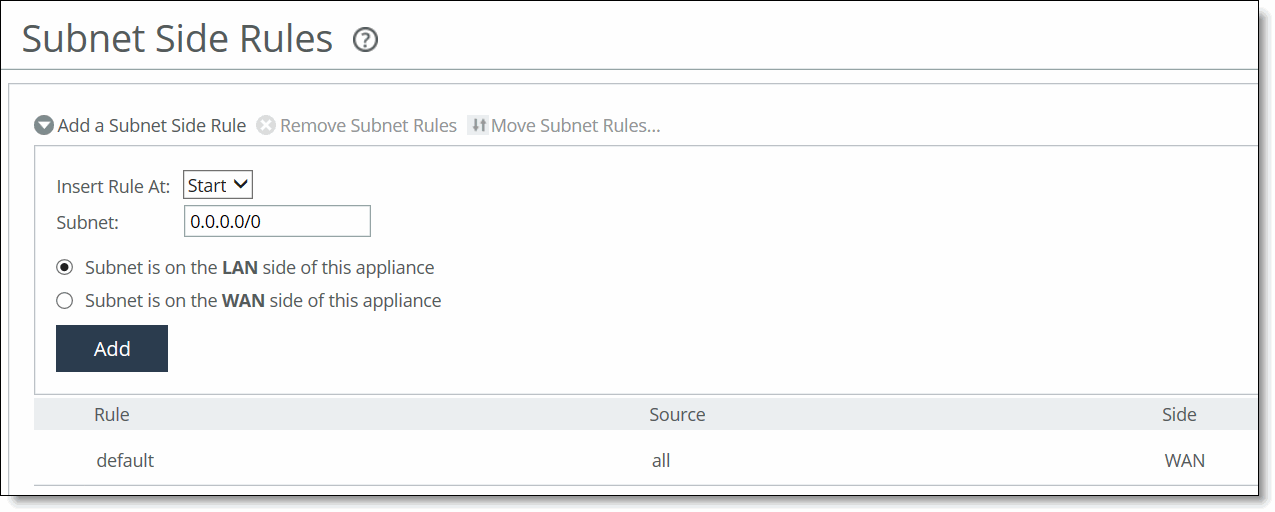Configuring Subnet Side Rules
Networking > Network ServicesSteelHead Deployment GuideYou configure subnet side rules in the Configure > Networking > Subnet Side Rules page.
Subnet side rules enable you specify subnets as LAN-side subnets or WAN-side subnets for a virtual in-path Steelhead appliance. Subnet side rules instruct the Steelhead appliance to identify traffic as originating from the WAN side of the appliance or the LAN side of the appliance based on the source subnet. You must configure subnets on each Steelhead appliance in a virtual in-path configuration, as the subnets for each will likely be unique.
For Steelhead appliances configured for virtual in-path deployment (for Layer-4 switch, PBR, WCCP, and SteelHead Interceptor), you must configure subnet side rules to support client-side appliances or for appliances that support flow export collectors such as NetFlow. You must configure subnets on each Steelhead appliance in a virtual in-path configuration, as the subnets for each will likely be unique.
Note: If you configure a client-side Steelhead appliance for virtual in-path deployment, you must configure subnet side rules to identify LAN-side traffic, otherwise the appliance does not optimize traffic from client-side connections. In virtual in-path configurations, all traffic flows in and out of one physical interface, and the default subnet side rule causes all traffic to appear to originate from the WAN side of the device.
Because VSP is enabled by default on SteelHead EXs, and the default subnet rule assumes that all traffic is coming from the WAN, the default rule prevents client-side connections from being optimized until you create a rule to identify traffic that should be treated as LAN-side traffic. The position of this rule must be at the start of the list of rules, above the default rule.
• If you configure a virtual in-path Steelhead appliance to use flow export collectors such as NetFlow analyze nonoptimized traffic or passed-through traffic correctly. If you do not configure subnet side rules configured, the SteelHead cannot discern whether the traffic is traveling from the LAN to the WAN or in the opposite direction. This can result in over-reporting traffic in a particular direction or for a particular interface.
FakeIndex is necessary for correct optimized traffic reporting. For details, see the Steelhead Appliance Deployment Guide.
To add subnet side rules
1. Choose Networking > Network Services: Subnet Side Rules to display the Subnet Side Rules page.
Figure: Subnet Side Rules Page

2. Complete the configuration as described in this table.
Control | Description |
Add a Subnet Side Rule | Displays the controls to create a subnet side rule. |
Insert Rule At | Select Start, End, or a rule number from the drop-down list. SteelHeads evaluate rules in numerical order starting with rule 1. If the conditions set in the rule match, then the rule is applied, and the system moves on to the next packet. If the conditions set in the rule don’t match, the system consults the next rule. For example, if the conditions of rule 1 don’t match, rule 2 is consulted. If rule 2 matches the conditions, it is applied, and no further rules are consulted. |
Subnet | Specify the subnet. Use the following format: <ip address>/<subnet mask> |
Subnet is on the LAN side of this appliance | In virtual in-path configurations, all traffic is flowing in and out of one physical interface. Select to specify that the subnet is on the LAN side of the device. |
Subnet is on the WAN side of this appliance | In virtual in-path configurations, all traffic is flowing in and out of one physical interface. Select to specify that the subnet is on the WAN side of the device. |
Add | Adds the rule to the subnet map table. The Management Console redisplays the subnet map table and applies your changes to the running configuration, which is stored in memory. |
Remove Subnet Rules | Select the check box next to the name and click Remove Subnet Rules. |
Move Subnet Rules | Moves the selected rules. Click the arrow next to the desired rule position; the rule moves to the new position. |
You can’t delete the default rule that optimizes all remaining WAN side traffic that has not been selected by another rule. This rule is always listed last.
Related Topics


